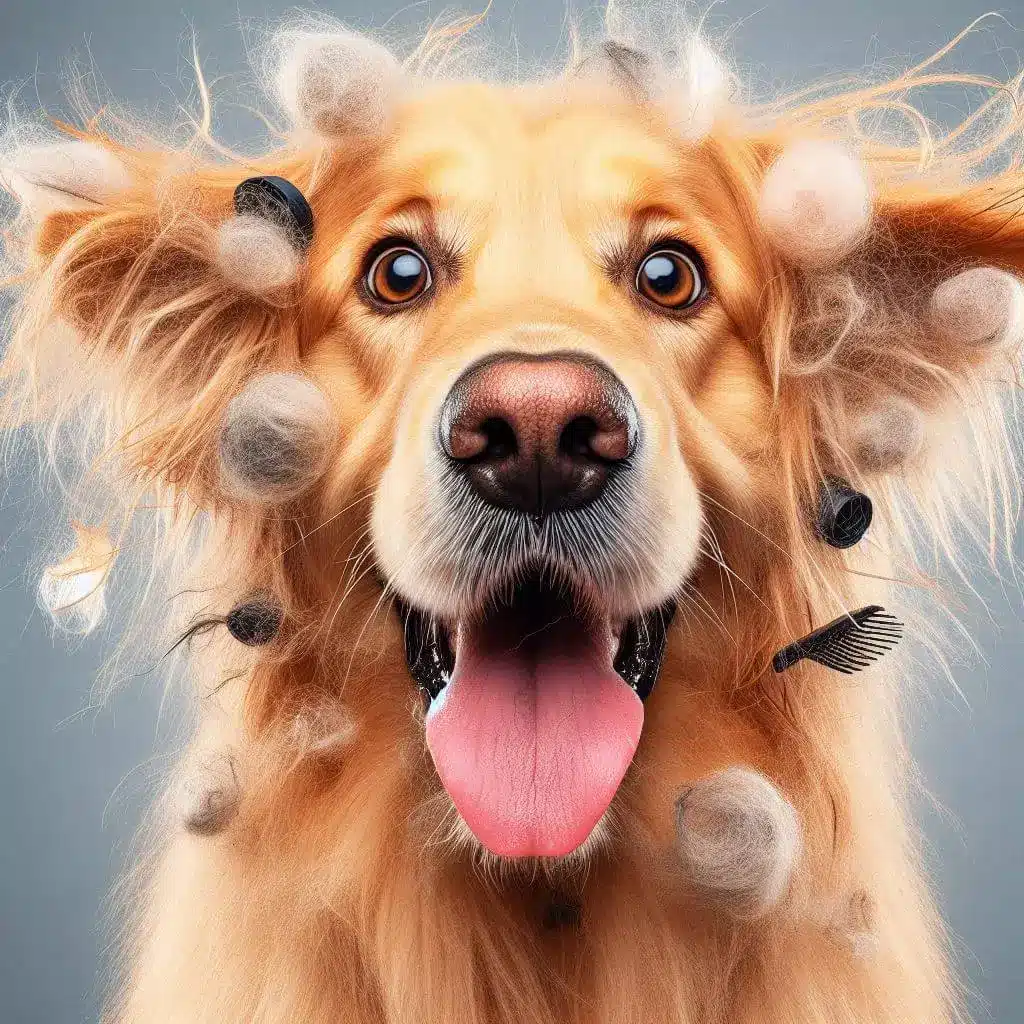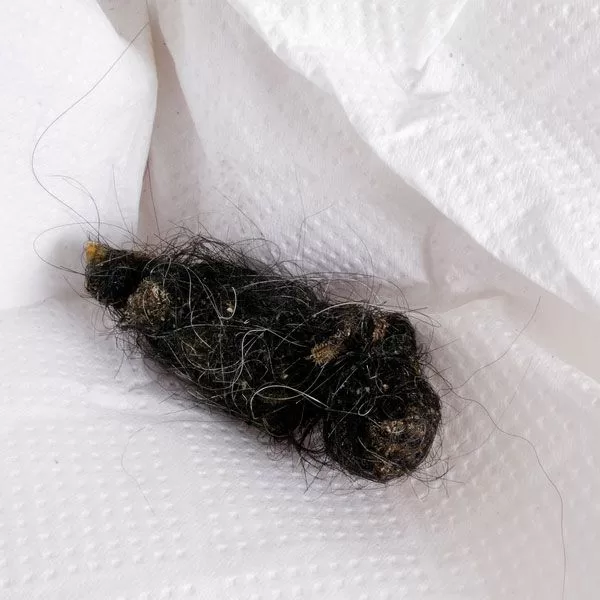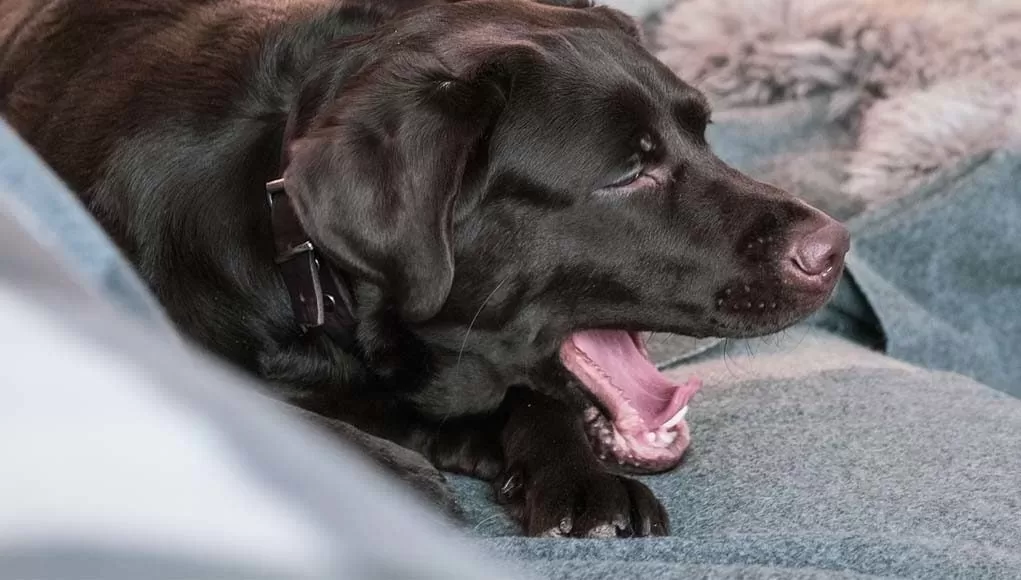Hairballs in dogs can be very troublesome if not taken care of properly. Although it’s normal for dogs to groom themselves, excessive amounts of ingested hair can lead to hairballs. Fortunately, there are simple steps you can take to prevent and manage hairballs in dogs.
Here is a comprehensive guide on the best ways to deal with hairballs in dogs, covering everything from basics to advanced tips. This guide will help you understand what causes hairballs, how to prevent them, how to treat them, and when to seek veterinary help.
Table of Contents
What hairballs are and why dogs get hairballs?

Hairballs, also known as trichobezoars or furballs, are clumps of hair that form in a dog’s stomach or intestines when they ingest their own fur or the fur of other animals. Hairballs are more common in cats, but they can also affect dogs, especially those with long hair, skin conditions, or compulsive grooming habits. Hairballs can vary in size and shape, but they usually look like cylindrical masses of compacted fur, sometimes mixed with food or other debris.
Hairballs in dogs are a common occurrence in dogs, and can occur for a number of reasons. Most commonly, they are caused by ingesting loose hair, which accumulates in the dog’s digestive tract and forms a blockage. This blockage can cause a variety of symptoms including coughing, vomiting, vomiting and loss of appetite.
In more severe cases, the blockage can cause abdominal discomfort and even constipation. Although hairballs are not usually life-threatening, they can be uncomfortable and unpleasant for your pet.
Also Read: How High Can a German Shepherd Jump?
The best way to prevent hairballs is to groom your dog. Regular brushing can help remove excess fur and reduce the amount of hair your dog sheds. If your pet is prone to hairballs, special foods are also available to help reduce the occurrence of hairballs.
What causes hairballs in dogs?
Dogs can swallow hair for various reasons, such as:
- Grooming themselves or other animals, especially if they have itchy, dry, or irritated skin.
- Chewing or biting their fur due to stress, boredom, anxiety, or behavioral issues.
- Eating hair that they find on the floor, furniture, or bedding.
- Having parasites, such as fleas, ticks, or worms, that make them scratch or lick their skin more often.
- Having allergies, infections, or hormonal imbalances that affect their skin or coat health.
Normally, the hair that dogs swallow passes through their digestive system and comes out in their feces. However, sometimes the hair can accumulate in the stomach or intestines and form a hairball. This can happen if the dog swallows too much hair, has a slow or weak digestive motility, or has an underlying gastrointestinal disorder.
What are the symptoms of hairballs in dogs?
Some dogs may not show any symptoms of having hairballs, while others may experience:
- Vomiting or regurgitating hairballs, which may be accompanied by bile, food, or blood.
- Loss of appetite or weight loss, due to feeling full or nauseous from the hairball.
- Abdominal pain or discomfort, which may make the dog restless, lethargic, or irritable.
- Constipation or diarrhea, due to the hairball interfering with the normal bowel movements.
- Dehydration or electrolyte imbalance, due to the loss of fluids and nutrients from vomiting or diarrhea.
- Gagging, coughing, or wheezing, due to the hairball irritating the throat or lungs.

How to prevent hairballs in dogs?
The best way to prevent hairballs in dogs is to reduce the amount of hair that they ingest and improve their digestive health. Some of the preventive measures that you can take are:
- Brush your dog regularly, preferably daily, to remove loose or dead hair from their coat. This will also help distribute the natural oils and keep their skin and fur healthy and shiny. Use a suitable brush or comb for your dog’s hair type and length, and dispose of the hair properly.
- Bathe your dog as needed, using a mild shampoo and conditioner that are suitable for their skin and coat. This will help remove dirt, debris, and excess hair from their fur, and prevent skin infections and irritation. Rinse and dry your dog thoroughly after bathing, and avoid using harsh or human products that may cause allergic reactions or dryness.
- Feed your dog a high-quality, balanced, and digestible diet that meets their nutritional needs and preferences. Avoid giving your dog table scraps, bones, or foods that may cause allergies, intolerance, or indigestion. You can also add some fiber, such as canned pumpkin, oat bran, or psyllium husk, to your dog’s food to help them pass the hair more easily. Alternatively, you can give your dog a hairball remedy, such as a gel, paste, or chew, that contains lubricants, enzymes, or laxatives to help dissolve or expel the hairball. However, consult your veterinarian before giving your dog any supplements or medications, and follow the instructions carefully.
- Provide your dog with plenty of fresh water and encourage them to drink regularly. This will help keep them hydrated and prevent dehydration and electrolyte imbalance. It will also help flush out the hair and other waste from their system and prevent constipation or diarrhea.
- Keep your dog’s environment clean and hair-free. Vacuum, sweep, or mop the floors, furniture, and bedding where your dog spends time, and wash their toys, bowls, and bedding regularly. This will help reduce the amount of hair that your dog may ingest from their surroundings, and prevent them from ingesting other harmful substances, such as dust, dirt, or chemicals.
- Address any underlying issues that may cause your dog to swallow hair, such as parasites, allergies, infections, or behavioral problems. Consult your veterinarian for diagnosis and treatment, and follow their recommendations. You may need to give your dog medications, such as antihistamines, antibiotics, or steroids, or use topical products, such as shampoos, sprays, or collars, to treat their condition. You may also need to change your dog’s diet, eliminate potential allergens, or use hypoallergenic products. For behavioral issues, such as stress, boredom, or anxiety, you may need to provide your dog with more exercise, mental stimulation, socialization, or training, or seek the help of a professional dog trainer or behaviorist.
How to treat hairballs in dogs?
Most hairballs in dogs are harmless and can be vomited up or passed in the feces without any complications. However, if your dog has difficulty vomiting or defecating, or shows signs of an obstruction, such as persistent vomiting, abdominal pain, lack of appetite, or weight loss, you should seek veterinary attention immediately. A hairball that is too large or too hard to pass can cause a serious blockage in the stomach or intestines, which can lead to infection, perforation, or death.
Your veterinarian will examine your dog and perform some tests, such as blood work, X-rays, ultrasound, or endoscopy, to confirm the diagnosis and locate the hairball. Depending on the size, location, and severity of the hairball, your veterinarian may recommend one of the following treatments:
- Medication. Your veterinarian may prescribe some medications, such as antiemetics, antacids, or antibiotics, to help your dog vomit, reduce inflammation, or prevent infection. They may also give your dog a hairball remedy, such as a gel, paste, or chew, that contains lubricants, enzymes, or laxatives, to help dissolve or expel the hairball.
- Manual removal. Your veterinarian may try to remove the hairball manually, using a long, flexible tube called an endoscope, that is inserted through your dog’s mouth or anus. The endoscope has a camera and a light at the end, which allows your veterinarian to see inside your dog’s stomach or intestines. The endoscope also has a tool that can grab, cut, or suction the hairball out of your dog’s body.
- Surgery. If the hairball is too large or too firmly lodged to be removed by medication or endoscopy, your veterinarian may need to perform surgery to remove it. This involves making an incision in your dog’s abdomen and opening the stomach or intestines to access and remove the hairball. Surgery is a more invasive and risky procedure, and requires general anesthesia, hospitalization, and post-operative care.
When to seek veterinary help for hairballs in dogs?
If your dog vomits up a hairball occasionally, and does not show any signs of distress or illness, you do not need to worry. However, if your dog vomits up hairballs frequently, or shows any of the following signs, you should contact your veterinarian as soon as possible:
- Persistent or severe vomiting, with or without hairballs
- Abdominal pain or swelling
- Loss of appetite or weight loss
- Constipation or diarrhea
- Dehydration or electrolyte imbalance
- Gagging, coughing, or wheezing
- Lethargy or depression
- Fever or infection
These signs may indicate that your dog has a hairball that is causing an obstruction, or that your dog has another underlying condition that needs to be addressed. Your veterinarian will be able to diagnose and treat your dog accordingly, and prevent any serious complications or damage to your dog’s health.
What are some common dog breeds that get hairballs?
Some common dog breeds that get hairballs are those with long or thick fur that sheds heavily, such as the German Shepherd, Siberian Husky, and Golden Retriever. These breeds have hair that is more likely to clump and form hairballs in their stomach or intestines. Other factors that can increase the risk of hairballs in dogs are skin conditions, parasites, allergies, or compulsive grooming habits that make them swallow more hair.
Can hairballs cause diarrhea in dogs?
Yes, hairballs can cause diarrhea in dogs. Diarrhea is a sign that the dog’s body is trying, but failing, to expel a stomach obstruction such as a large, hardened hairball. This typically happens when the hairball is too large and solid to pass with feces. Diarrhea can also lead to dehydration and electrolyte imbalance, which can be dangerous for your dog’s health.
If your dog has diarrhea due to a hairball, you should consult your veterinarian for diagnosis and treatment. Your veterinarian may prescribe some medications, such as antiemetics, antacids, or antibiotics, to help your dog vomit, reduce inflammation, or prevent infection.
They may also give your dog a hairball remedy, such as a gel, paste, or chew, that contains lubricants, enzymes, or laxatives, to help dissolve or expel the hairball. In some cases, your veterinarian may need to remove the hairball manually or surgically, depending on the size, location, and severity of the hairball.
Conclusion
Hairballs in dogs are uncommon but can occur under certain circumstances. They are usually harmless and can be vomited up or passed in the feces, but they can also cause an obstruction in the stomach or intestines, which can be life-threatening.
The best way to deal with hairballs in dogs is to prevent them from forming in the first place, by reducing the amount of hair that your dog ingests and improving their digestive health. If your dog has difficulty vomiting or defecating, or shows signs of an obstruction, you should seek veterinary help immediately.
Your veterinarian will be able to remove the hairball by medication, endoscopy, or surgery, and restore your dog’s health and comfort.

